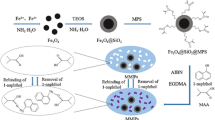Abstract
A fluorescent magnetic surface molecular imprinting method was used to detect naringin by fluorescence polarization technology. By using SiO2-coated magnetic particles as substrate and methacrylic acid and acrylamide as monomers, a surface molecular imprinting polymer with both fluorescence and magnetic characteristics was prepared and loaded with fluorescein isothiocyanate. The binding ability of the prepared polymer was tested by fluorescence polarization and ultraviolet (UV) spectrophotometry. Compared with UV detection method, the fluorescence polarization method was more sensitive, and its limit of detection was 0.1 mg/L. The recovery of the fluorescence polarization method was higher than 81.3%. It was shown that the fluorescent magnetic surface molecular imprinting technique could be a new method to detect naringin quickly and efficiently in food.








Similar content being viewed by others
Abbreviations
- TEM:
-
Transmission electron microscopy
- UV:
-
Ultraviolet spectroscopy
- HPLC:
-
High-performance liquid chromatography
- MIPs:
-
Molecularly imprinted polymers
- EGDE:
-
Ethylene glycol diglycidyl ether
- TEOS:
-
Tetraethyl orthosilicate
- FITC:
-
Fluorescein isothiocyanate
- NG:
-
Naringin
- TTS:
-
Triethoxyvinylsilane
References
Widmer W, Brause A, Coppola E, Daniels K, Trama T (2000) Determination of Naringin and neohesperidin in orange juice by liquid chromatography with UV detection to detect the presence of grapefruit juice: collaborative study. J AOAC Int 83(5):1155–1166
Hongwei Yu, Weina Gu, Li Na (2011) Research progress of Naringin. Hubei Agric Sci 50(8):1516–1518
Ma X, Chen R, Zheng Xi, Chen X, Chen Z (2010) Preparation and application of Naringin sensor based on molecularly imprinting technique. Chin J Anal Chem 38(1):100–104
Li C, Jian Yu, Zeng L, Liu Z (2008) Study of antioxidation of Naringin on pork meat. Food Res Dev 29(10):20–23
Kontogianni A, Skouridou V, Sereti V, Stamatis H, Kolisis FN (2003) Lipase-catalyzed esterification of rutin and naringin with fatty acids of medium carbon chain. J Mol Catal B Enzym 21(1–2):59–62
Hou GX, Liu X, Ding Y, Fan X, Li X, Wang S (2015) Synthesis and antiturnor activity of rare earth complexes with Naringin. J Cannan Med Univ 35(1):31–32
Zeng X, Weiwei SU, Bai Y, Peng W, Yao H (2017) HPLC-MS/MS method for simultaneous determination of naringin and naringenin in human plasma. Acta Sci Natur Univ Sunyatseni 56(1):125–130
Luan L-J, Jiang Z-H, Mi S-Y, Yong-jiang Wu (2011) Comprehensive quality control method for total flavonoid of Fructus Aurantii. J Zhejiang Univ 40(1):17–22
Yang Q, Wu X, Peng H, Fu L, Song X, Li J, Xiong H, Chen L (2018) Simultaneous phase-inversion and imprinting based sensor for highly sensitive and selective detection of bisphenol A. Talanta 176:595–603
Udomsap D, Branger C, Culioli G, Dollet P, Brisset H (2014) A versatile electrochemical sensing receptor based on a molecularly imprinted polymer. Chem Commun 50:7488–7491
El Gohary NA, Madbouly A, El Nashara RM, Mizaikoff B (2015) Synthesis and application of a molecularly imprinted polymer for the voltammetric determination of famciclovir. Biosens Bioelectron 65:108–114
Yang Q, Peng H, Li J, Li Y, Xiong H, Chen L (2017) Label-free colorimetric detection of tetracycline using analyte-responsive inverse-opal hydrogels based on molecular imprinting technology. New J Chem 41:10174–10180
Chen L, Xu S, Li J (2011) Recent advances in molecular imprinting technology: current status, challenges and highlighted applications. Chem Soc Rev 40:2922–2942
Chen L, Wang X, Lu W, Wu X, Li J (2016) Molecular imprinting: perspectives and applications. Chem Soc Rev 45:2137–2211
Zhao Chen Wu, Daocheng. (2013) Rapid detection assay for the molecular imprinting of gossypol using a two-layer PMAA/SiO2 bulk structure with a piezoelectric imprinting sensor. Sens Actuators B Chem 181:104–113
Chen Z, Jia Guangfeng Lu, Wenzong GQ (2017) A piezoelectri magnietic molecularly imprinted surface sensor for the detection of Sudan I. J Alloys Compd 710:711–716
Zhao C, Ren Y, Lu W, Zhang M (2016) Detection of piezoelectric magnetic surface molecularly imprinted sensor to chloramphenicol. Sci Technol Eng 16:149–153
Zhao C, Jia G, Wenzong Lu, Gong Q (2016) Detection of Sudan I in food using magnetic molecularly imprinted polymer microspheres. Modern Food Sci Technol 32:302–307
Wenzong Lu, Ni Y, Jia G, Pan H, Zhao C (2014) Rapid fluorescence polarization immunoassay for highly sensitive detection of 2,4,6-trinitrotoluene. Asian J Chem 26(3):773–776
Acknowledgements
The authors are grateful to all the study participants.
Funding
This research was funded by Natural Science Foundation Research Project of Shaanxi Province of China, grant number 2018JQ2075.
Author information
Authors and Affiliations
Contributions
All authors have read and agree to the published version of the manuscript. Conceptualization, CZ; methodology, YR; formal analysis, GL; writing—original draft preparation, CZ; writing—review and editing, YR.
Corresponding author
Ethics declarations
Conflict of interest
The authors declare no conflicts of interest.
Ethics approval and consent to participate
Not applicable.
Consent for publication
Not applicable.
Availability of data and material
The data sets used and/or analyzed during the current study are available from the corresponding author on reasonable request.
Additional information
Publisher's Note
Springer Nature remains neutral with regard to jurisdictional claims in published maps and institutional affiliations.
Rights and permissions
About this article
Cite this article
Zhao, C., Ren, Y. & Li, G. Detection of naringin by fluorescent polarization molecularly imprinted polymer. Polym. Bull. 80, 1411–1424 (2023). https://doi.org/10.1007/s00289-022-04115-3
Received:
Revised:
Accepted:
Published:
Issue Date:
DOI: https://doi.org/10.1007/s00289-022-04115-3




